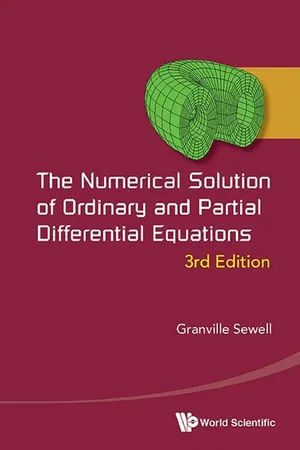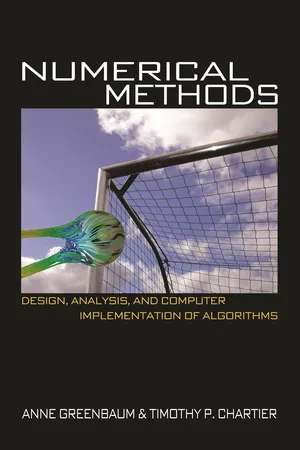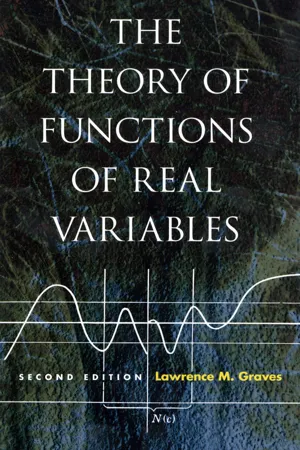Mathematics
Initial Value Problem Differential Equations
The initial value problem in differential equations involves finding a solution that satisfies both the given differential equation and specified initial conditions. These initial conditions typically involve the value of the function and its derivatives at a specific point. Solving the initial value problem allows for the determination of a unique solution to the differential equation.
Written by Perlego with AI-assistance
Related key terms
Related key terms
1 of 4
Related key terms
1 of 3
12 Key excerpts on "Initial Value Problem Differential Equations"
- Granville Sewell(Author)
- 2014(Publication Date)
- WSPC(Publisher)
1 Initial Value Ordinary Differential Equations1.0 IntroductionDifferential equations are often divided into two classes, ordinary and partial, according to the number of independent variables, and studied separately. A more meaningful division, however, is between initial value problems, which usually model time-dependent phenomena, and boundary value problems, which generally model steady-state systems. The differences between initial value and boundary value problems, and the similarities within each of these classes, are even more striking when numerical methods for these problems are considered.The identification of initial value problems with time dependency and of boundary value problems with a steady-state condition is helpful in understanding some of the differences in the properties of these two types of problems. For example, the solution at any time of a time-dependent problem logically depends only on what has gone on before and not on future events. For a steady-state problem, on the other hand, the solution values at different spatial points may be interdependent. Thus it is not surprising that a time-dependent (initial value) problem can be solved numerically by marching forward in time from the given initial values, while a system of simultaneous algebraic equations must generally be solved to find the solution to a steady-state (boundary value) problem.It is also clear why initial value problems almost always have unique solutions, while boundary value problems sometimes have many or no solutions. Consider, for example, the general second-order equation mutt= f(t, u, ut), which may be thought of as modeling Newton’s second law, applied to an object whose coordinates are given by the vector u(t). With initial conditions u(0) = u0 , ut(0) = u1 , under very reasonable smoothness assumptions on the force field f, this problem will always have a unique solution. To find it, one only needs to create the force field described by f and release the object with the prescribed initial position and velocity. The object will find the solution even if we cannot! With boundary conditions u(0) = u0 , u(1) = u1 , there is no guarantee that a unique solution exists, as we are now requiring that the object travel from point u0 to point u1- Lennart Edsberg(Author)
- 2015(Publication Date)
- Wiley(Publisher)
Chapter 3 Numerical Methods For Initial Value Problems As we have seen in Chapters 1 and 2, ordinary differential equation(ODE) problems occur in numerous applications and therefore important for modeling processes whose evolution depends on one variable, usually time or one spatial variable. In this chapter, we treat the initial value problem (IVP). The general formulation of an IVP is 3.1 Often the solution depends on parameters, denoted by the vector, that occur in the right hand side function: 3.2 The initial values can also be regarded as parameters in case the dependence of the initial values is studied: Example 3.1 (Newton's law for a particle) In Exercise 2.1.4, the following IVP was introduced 3.3 This ODE models a particle thrown vertically from the position and with initial velocity. The particle is influenced by gravityand an air resistance force being proportional to the square of the velocity. When the solution is studied as a function of, e.g.,, we make a parameter study of the problem- eBook - ePub
Approximation Techniques for Engineers
Second Edition
- Louis Komzsik(Author)
- 2017(Publication Date)
- CRC Press(Publisher)
11Initial value problems
Initial value problems are an important subject of engineering. Many of these problems arise from modeling various physical phenomena, but considerably fewer of them may be solvable analytically, hence the intense interest in approximate solutions. Historical names such as Euler and Taylor are associated with the subject and their classical methods will be discussed in detail.An excellent survey of the area is in [4 ]. The focus of this chapter will be initial value problems of ordinary differential equations and systems of ordinary differential equations. Some of the methods are applicable to partial differential equations as well.It is important to point out that the approximate solution of initial value problems will not be given in the form of an approximate function. Rather, it will be given in terms of approximate solution values at discrete points. This effectively reverses the approach of the first part of the book by seeking a function approximating some discrete points.11.1 Solution of initial value problems
An initial value problem (IVP) of a first order ordinary differential equation is posed aswith the initial condition of= f ( t , y ) ; a ≤ t ≤ b ,d yd ty (a ) = y 0 .The analytic solution of the problem isy (t ),which may not be possible or feasible to compute analytically. The solution to such a problem exists under certain conditions. The so-called Lipschitz condition is defined with a constant L > 0 on a set D ∈ R 2 as|f (t , y 1 ) − f (t , y 2 )| ≤ L |y 1 − y 2 |,where L is called the Lipschitz constant. If the function f (t , y ) is continuous on the domainD = [a ≤ t ≤ b ; −∞ < y < ∞],and satisfies the Lipschitz condition, then the initial value problem has a unique solution.The somewhat ambiguous definition of this condition may be improved as follows. Let us define a domain D to be convex if, for any two points in the domain, the line segment connecting the two points is also in the domain in its entirety. If the function is defined and differentiable on a convex domain and there exists a number L - Paul DuChateau(Author)
- 2013(Publication Date)
- Dover Publications(Publisher)
4Ordinary Differential Equations: Linear Initial Value Problems
N ow we will focus on three types of problems for ordinary differential equations: linear initial value problems, linear boundary value problems, and nonlinear problems. This chapter is devoted to linear initial value problems.We begin by introducing a minimum amount of notation and terminology and then proceed to consider the initial value problem for a single homogeneous equation with particular attention to equations with constant coefficients.The initial value problem for a single inhomogeneous equation is treated by means of the Laplace transform. This technique is particularly suited to analyzing the input-output relationship for physical systems modeled by ordinary differential equations.Physical systems with more than a single degree of freedom are often modeled by systems of ordinary differential equations. If the number of degrees of freedom is small—say, two or three—then the Laplace transform is a feasible solution method. For systems involving larger numbers of equations, solution methods based on linear algebra concepts from Chapter 2 are liable to be more effective. Examples of both kinds are discussed.INITIAL VALUE PROBLEMS FOR SINGLE EQUATIONS
Terminology and Notation
DIFFERENTIAL EQUATIONS
This chapter is devoted to the topic of ordinary differential equations. Differential equations involve an unknown function and one or more of its derivatives and if the unknown is a function of a single variable, then the differential equation is said to be an ordinary Differential equation. We denote the derivatives of the single variable function y (t- eBook - ePub
Numerical Methods
Design, Analysis, and Computer Implementation of Algorithms
- Anne Greenbaum, Tim P. Chartier(Authors)
- 2012(Publication Date)
- Princeton University Press(Publisher)
11
NUMERICAL SOLUTION OFTHE INITIAL VALUE PROBLEMFOR ORDINARY DIFFERENTIALEQUATIONS
In this chapter we study problems of the formwhere the independent variable t usually represents time, y ≡ y (t ) is the unknown function that we seek, and y 0 is a given initial value. This is called an initial value problem (IVP) for the ordinary differential equation (ODE) y ′ = (t, y ). (Sometimes the differential equation holds for t ≤ t 0 or for t in some interval about t 0 . Such problems are still referred to as initial value problems.) For now, we will assume that y is a scalar-valued function of t . We will later consider systems of ODEs. We start with some examples.Example 11.0.1. The rate of growth of a population with no external limits is proportional to the size of the population. If y (t ) represents the population at time t , then y ′ = ky for some positive constant k . We can solve this equation analytically: y (t ) =Cektfor some constant C . Knowing the initial size of the population, say, y (0) = 100, we can determine C ; in this case C = 100. Thus a population with no external limits grows exponentially (but such populations do not exist for long before food, space, etc. begin to impose limits).This model of population growth is known as the Malthusian growth model, named after Thomas Malthus who developed the model in his anonymously authored book An Essay on the Principle of Population published in 1798. The constant k - Stephen L. Campbell, Richard Haberman(Authors)
- 2011(Publication Date)
- Princeton University Press(Publisher)
x = 7 in (5), we getso that the constant c is determined to be c = . Thus, the unique solution of the differential equation that satisfies the given initial condition isMore generally, we might wish to solve the differential equation subject to the initial conditionWe introduce the symbol t 0 for the value of t at which the solution is given. Often t 0 = 0, but in the previous example, we had t 0 = 2 and x 0 = 7. We refer to (6) with the initial condition (7) as the initial value problem for the differential equation. We can always write a formula for the solution of (6) using an indefinite integralEquation (5) is a specific example of (8). If we can obtain an explicit indefinite integral (antiderivative) of f (t ), then this initial value problem can be solved like Example 1.2.1. Explicit integrals of various functions f (t ) may be obtained by using any of the various techniques of integration from calculus. Tables of integrals or symbolic integration algorithms such as MAPLE or Mathematica that are available on more sophisticated calculators, personal computers, or larger computers may be used. However, if one cannot obtain an explicit integral, then it may be difficult to use (8) directly to satisfy the initial conditions.1.2.2 The Initial Value Problem and the Definite Integral
A definite integral should usually be used to solve the differential equation = f (t ) if an explicit integral is not used. The result can automatically incorporate the given initial condition x (t 0 ) = x 0 . If both sides of the differential equation (6) are integrated with respect to t from t 0 to t , we getwhere we have introduced the dummy variable . The left-hand side equals = x (t ) − x (t 0 ), since the antiderivative of is x . We obtain the same result canceling , since- eBook - ePub
Mathematical Modeling
Branching Beyond Calculus
- Crista Arangala, Nicolas S. Luke, Karen A. Yokley(Authors)
- 2018(Publication Date)
- Chapman and Hall/CRC(Publisher)
t is an independent variable. Furthermore, in an introductory differential equations course, we learned that a differential equation is any equation that contains a derivative, or differentials. Because differential equations can be used to define derivatives, or rates of change, they can be used to model virtually any quantity or system that changes over time. In this chapter, we’ll discuss how to build and solve a variety of differential equations models.When creating a differential equations model, the goal is to derive a mathematical representation of how a quantity of interest is changing. This quantity is the dependent variable in the equation, and is referred to as a state variable or state of the model. The independent variable from the differential equation usually represents a physical attribute such as time or distance. Other parameters or constants that are present within the model are referred to as parameters.Recall that a differential equation that is coupled with a set of additional constraints on the dependent variable and its derivatives at a particular input (called initial conditions) is called an initial value problem. When constructing a mathematical model using a differential equation, it is desirable to create a model that has a single unique solution rather than a family of solutions. Because of this aspect of the modeling process, the majority of the differential equations models that we will construct or encounter will be initial value problems. While modeling with differential equations, we may also encounter boundary value problems, which consist of a differential equation with additional constraints on the dependent variable and/or its derivatives at different inputs (called boundary conditions).Within the next sections of this chapter, we will discuss how to construct and solve differential equations models. One aspect of the construction process that we won’t discuss very much is the importance of making units match. When formulating a differential equation that will be used to represent physical processes, we must keep in mind that the units of the model must match the units of the physical process. For example, consider the following equation that is part of an SVIR disease model, - Michael D. Greenberg(Author)
- 2014(Publication Date)
- Wiley(Publisher)
CHAPTER 1
First-Order Differential Equations
Section 1.1
This first section is simply to introduce you to differential equations: what they look like, some ideas as to how they arise in applications, and some important definitions. We see that the complete problem might be not just the differential equation, but also one or more "initial conditions." If such conditions are prescribed, the problem is called an initial value problem, or IVP. For instance, (6) [that is, equation (6) in the text] is an IVP because in addition to the DE (differential equation) there are two initial conditions, given by (6b), so that the solution of the IVP must satisfy not only the DE (6a), but also those two initial conditions.Chapter 1 is about first-order equations; that is, equations in which the highest derivative is of first order. In that case, hence all through Chapter 1, there will be only one initial condition. In later chapters we will find that the "appropriate" number of initial conditions for a DE is the same as the order of the equation. For instance, (6a) is of second order and, sure enough, there are two initial conditions in (6b).The distinction between linear and nonlinear differential equations will be of great importance, so it is necessary to be able to tell if a given equation is linear or nonlinear. Later, we will find that the key is whether or not a certain linearity property is satisfied, but for now it will suffice not to know about that property, but simply to say that an nth-order equation is linear if it is in, or can be put into, the form (14). What is the form of (14)? First, put all occurrences of the unknown, that is, the dependent variable such as y in (14), on the LHS (left-hand side of the equation); anything else goes on the right. If the LHS is a linear combination of y, y ',…, y(n ), then the DE is linear. Actually, the "constants" that multiply y, y ',…, y(n )in (14) are permitted to be functions of x ; the point is that they don't depend on y- eBook - ePub
Engineering Analysis
Interactive Methods and Programs with FORTRAN, QuickBASIC, MATLAB, and Mathematica
- Yen-Ching Pao(Author)
- 2019(Publication Date)
- CRC Press(Publisher)
6 Ordinary Differential Equations — Initial and Boundary Value Problems 6.1 INTRODUCTION An example of historical interest in solving an unknown function which is governed by an ordinary differential equation and an initial condition is the case of finding y(x) from: d y d x = y a n d y (x = 0) = 1 (1) As we all know, y(x) = e x. In fact, the exponential function e x is defined by an infinite series: e x = 1 + x 1 1 ! + x 2 2 ! + … = ∑ i = 0 ∝ x i i ! (2) To prove that Equation 2 indeed is the solution for y satisfying Equation 1, here we apply an iterative procedure of successive integration using a counter k. First, we integrate both sides of Equation 1 with respect to x: ∫ 0 x d y d x d x = ∫ 0 x y d x (3) After substituting the initial condition of y(x = 0) = 1, we obtain: y (x) = 1 + ∫ 0 x y d x (4) So we are expected to find an unknown y(x) which is to be obtained by integrating it? Numerically, we can do it by assuming a y(x) initially (k= 1) equal to 1, investigate how Equation 4 would help us to obtain the next (k = 2), guessed y(x), and hope eventually the iterative process would lead us to a solution. The iterative equation, therefore, is for k= 1,2,… y (k + 1) (x) = 1 + ∫ 0 x y (k) d x (5) The results are y (1) = 1, y (2) = 1 + x, y (3) = 1 + x + (x 2 /2!), and eventually the final answer is the infinite series given by Equation 2. What really need to be discussed in this chapter is not to obtain an analytical expression for y(x) by solving Equation 1 and rather to compute the numerical values of y(x) when x is equally incremented. That is, for a selected x increment, Δx (or, stepsize h), to find y i ≡ y(x i) for i = 1,2,… until x reaches a terminating value of x e and x i = (i-1) Δx. A simplest method to find y 2 is to approximate the derivative of y(x) by using the forward difference at x 1. That is, according to the notation used in Chapter 4, we can have: dy dx | x = x 1 = ˙ Δy 1 Δx = y 2 − y 1 Δx = y 1 (6) Or, y 2 = (1 + Δx)y 1 - eBook - ePub
Computational Physics
With Worked Out Examples in FORTRAN® and MATLAB®
- Michael Bestehorn(Author)
- 2023(Publication Date)
- De Gruyter(Publisher)
5 Ordinary differential equations II, boundary value problems 5.1 Preliminary remarks 5.1.1 Boundary conditions We continue considering systems of N ordinary differential equations of the first order (5.1) d y → (x) d x = f → (y → (x), x). Contrary to initial value problems, for boundary value problems one prescribes conditions at two (or more) different points, say x = a, b : (5.2) A _ y → (a) + B _ y → (b) = c →. Normally, a and b coincide with the boundaries of x and one wants to find solutions. for y → (x) in the region between a ≤ x ≤ b. The boundary conditions written in the form (5.2) linearly depend on y →. However, nonlinear boundary conditions may also occur, having the more general form g i (y → (a), y → (b)) = 0, i = 1 … N where the functions g i depend on 2 N variables. In practice, boundary conditions are often separable: (5.3) A _ 1 y → (a) = c → 1, B _ 1 y → (b) = c → 2. In order not to have an over- or under-determined problem, N linearly independent conditions must appear in (5.3). The initial value problem (4.2) from Chapter 4 is included in the form (5.3). with A _ 1 = 1 _, B _ 1 = 0, c → 1 = (r → i (0), v → i (0)). We shall restrict ourselves on linear, separable boundary conditions (5.3). Well-posed initial value problems normally have a unique solution. On the other hand, even linear boundary value problems may have multiple solutions or no solution at all. This becomes evident at a simple example. Consider the ODE of second order: y ″ + y = 0. For the boundary conditions y (0) = 0, y (π / 2) = 1 there is just one solution y (x) = sin x, while for y (0) = 0, y (π) = 0 we have infinitely many y (x) = A sin x with arbitrary A, and for y (0) = 0, y (π) = 1 there exists no solution at all. 5.1.2 Example: ballistic. flight A mass point starts at (x, y) = 0 with a certain given velocity v → (0) = (v x (0), v y (0)) in a constant gravity field and lands after a certain time t = T at x (T) = L, y (T) = 0 - Paul Sacks(Author)
- 2017(Publication Date)
- Academic Press(Publisher)
Chapter 1Some Basic Discussion of Differential and Integral Equations
Abstract
This chapter provides an introduction to the main types of problems which motivate the techniques developed throughout the textbook. Some general discussion of problems involving ordinary differential equations, partial differential equations, and integral equations is given, in order to establish notations, review needed background material, and explain some of the basic ways that such problems are classified. The chapter concludes with some discussion of the concepts of well-posed and ill-posed problems.Keywords
Differential equation; Integral equation; Characteristics; Boundary conditions; Laplace equation; Heat equation; Wave equation; Well-posed problemIn this chapter we will discuss “standard problems” in the theory of ordinary differential equations (ODEs), integral equations, and partial differential equations (PDEs). The techniques developed in this book are all meant to have some relevance for one or more of these kinds of problems, so it seems best to start with some awareness of exactly what the problems are. In each case there are some relatively elementary methods, which the reader may well have seen before, or which rely only on simple calculus considerations, which we will review. At the same time we establish terminology and notations, and begin to get some sense of the ways in which problems are classified.1.1 Ordinary Differential Equations
An n th order ordinary differential equation for an unknown function u = u (t ) on an interval( a , b ) ⊂ Ris any equation of the formF ( t , u ,u ′,u ″, … ,u) = 0( n )(1.1.1)where we use the usual notationsfor derivatives of orderu ′,u ″, …1 , 2 , …and also u(n )for derivative of order n- eBook - ePub
The Theory of Functions of Real Variables
Second Edition
- Lawrence M Graves(Author)
- 2012(Publication Date)
- Dover Publications(Publisher)
CHAPTER IX ORDINARY DIFFERENTIAL EQUATIONS1. Conditions Ensuring the Existence of Solutions. —In the following we shall let x denote the single real independent variable, and let y denote the dependent variables, of which there may be any finite number. Derivatives with respect to x will be denoted by accents. Thus a system of differential equations involving only first derivatives may be written in the formAn equation or a system of equations involving derivatives of higher orders may always be reduced to a system of the form (1:1) by the introduction of new dependent variables. For example, consider the equationIf we set y1 = y, y2 = y′, equation (1:2) is equivalent to the systemWe shall begin by considering systems of the formin which the derivatives are expressed explicitly as functions of x and y. Here it is understood that the number of equations is the same as the number of dependent variables y which are to be determined as functions of x. If there is only one equation and one variable y, the equation (1:4) may be pictured as attaching to each point in a region of the xy-plane a line whose slope is f(x, y). The problem of solving the differential equation is that of finding a curve having as its tangent at each point the line attached to that point. The extension of this geometrical interpretation to more dimensions is immediate.By a solution of (1:4) we shall mean a differentiable function y(x) defined on an (open or closed) interval (a, b) and such that y′(x) = f(x, y(x)) identically on (a, b). The set of all points (x, y(x)) with x on (a, b) is called thegraphof the solution. There will in general be infinitely many solutions. If we adjoin to the differential equation (1:4) initial conditions of the form y(ξ) = η, then the solution on an interval (a, b) containing ξ is uniquely determined, provided the function f has suitable properties. The requirement that the solution shall satisfy the initial condition y(ξ) = η is expressed geometrically by saying that the graph of the solution shall pass through the point (ξ, η). We shall be interested in studying the properties of the solution as a function y(x, ξ, η) of x and these initial values. The variables ξ and η constitute a special choice of the constants of integration, convenient for theoretical purposes. In a sufficiently restricted domain the complete family of solutions is obtained with the value of ξ fixed. In the first theorem to be proved the domain of the function f
Index pages curate the most relevant extracts from our library of academic textbooks. They’ve been created using an in-house natural language model (NLM), each adding context and meaning to key research topics.
Explore more topic indexes
Explore more topic indexes
1 of 6
Explore more topic indexes
1 of 4











